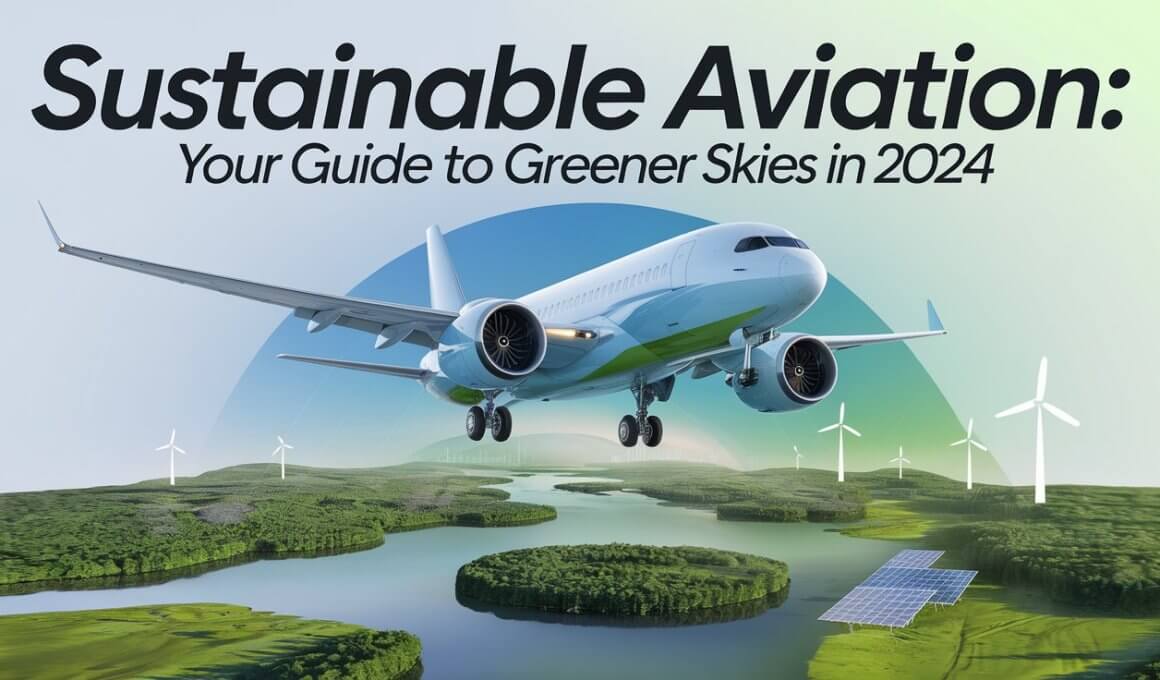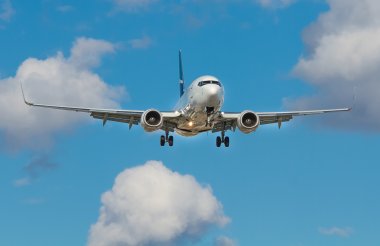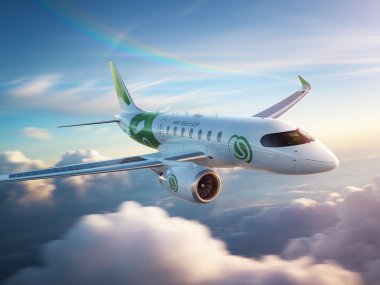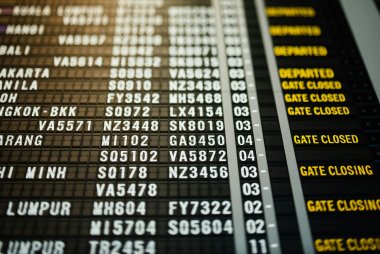As we enter 2024, the aviation industry finds itself at a critical juncture, balancing the growing demand for air travel with the urgent need to address climate change. With the sector responsible for 2.5% of global CO2 emissions, the quest for sustainable aviation has never been more pressing. Despite unprecedented challenges, the industry has made significant strides towards a greener future, driven by technological advancements, regulatory changes, and a collective commitment to sustainability. In this comprehensive overview, we’ll explore the current state of sustainable aviation, highlighting groundbreaking innovations, ambitious goals, and the challenges that lie ahead. Buckle up and join us on a journey through the skies of 2024, where the future of aviation is taking flight in a more sustainable way.
The rise of sustainable aviation fuels (SAF)
Sustainable Aviation Fuels (SAF) have emerged as a key solution to reducing the aviation industry’s carbon footprint. These innovative fuels, derived from sustainable sources such as waste oils, agricultural residues, and even captured CO2, offer a promising alternative to traditional jet fuel. SAF can reduce lifecycle greenhouse gas emissions by up to 80% compared to conventional fuels, making them a crucial tool in the fight against climate change.
The adoption of SAF has gained significant momentum in recent years, with several notable milestones:
- In 2021, the first commercial flight using 100% SAF took place, demonstrating the viability of these fuels.
- Major airlines, such as British Airways and Lufthansa, have committed to increasing their use of SAF in the coming years.
- Governments and regulatory bodies, particularly in Europe, have set ambitious targets for SAF usage, aiming for a 2% blend by 2025 and 63% by 2050.
As the demand for SAF grows, the industry is working to scale up production and reduce costs. Collaborative efforts between airlines, fuel producers, and governments are crucial to ensuring the widespread adoption of these sustainable fuels, paving the way for a greener future in aviation.
Technological innovations driving sustainable aviation
In addition to sustainable aviation fuels, the industry is witnessing a surge of technological innovations aimed at reducing the environmental impact of air travel. These advancements span across various aspects of aircraft design, propulsion systems, and operational efficiency.
One notable example is the development of electric and hybrid-electric aircraft. Companies like Airbus and Rolls-Royce are investing heavily in this technology, with plans to introduce hybrid-electric regional aircraft by the early 2030s. Electric propulsion systems offer the potential for zero-emission flights, particularly on shorter routes.
Another area of innovation is the use of lightweight materials and advanced aerodynamics in aircraft design. By reducing weight and improving airflow, these technologies can significantly enhance fuel efficiency. For instance, the introduction of composite materials like carbon fiber has allowed for lighter and more streamlined aircraft, resulting in reduced fuel consumption and emissions.
Other technological advancements driving sustainable aviation include:
- Improved air traffic management systems to optimize flight routes and reduce congestion
- The use of big data and artificial intelligence to analyze and optimize aircraft performance
- The development of more efficient engines, such as geared turbofans and open rotor designs
As these technologies continue to evolve and mature, they will play an increasingly crucial role in the aviation industry’s pursuit of sustainability, complementing the adoption of sustainable aviation fuels.
Industry commitments to net-zero emissions
The aviation industry has recognized the urgent need to address its environmental impact and has made ambitious commitments to reduce greenhouse gas emissions. In October 2021, the International Air Transport Association (IATA) announced a resolution to achieve net-zero carbon emissions by 2050. This commitment aligns with the Paris Agreement’s goal of limiting global warming to well below 2°C above pre-industrial levels.
To reach this target, the industry is focusing on a multi-faceted approach that includes:
- Accelerating the adoption of sustainable aviation fuels
- Investing in new aircraft technologies and more efficient operations
- Implementing carbon offset and reduction schemes
- Collaborating with governments and stakeholders to create supportive policies and incentives
Many individual airlines have also set their own targets for reducing emissions. For example, Delta Air Lines has committed to carbon neutrality by 2030, while United Airlines has pledged to reduce its greenhouse gas emissions by 100% by 2050.
These commitments demonstrate the aviation industry’s determination to play its part in the global fight against climate change. However, achieving net-zero emissions will require significant investments, technological advancements, and collaboration among all stakeholders. The path ahead is challenging, but the industry’s resolve to create a sustainable future for aviation is stronger than ever.
Global collaboration for a greener aviation future
Achieving a sustainable future for aviation requires a global effort, with collaboration among airlines, manufacturers, governments, and other stakeholders. International organizations such as the International Civil Aviation Organization (ICAO) play a crucial role in setting standards and fostering cooperation across borders.
One example of global collaboration is the Carbon Offsetting and Reduction Scheme for International Aviation (CORSIA). Developed by ICAO, CORSIA aims to stabilize net CO2 emissions from international aviation at 2019 levels through the use of carbon offsets and sustainable aviation fuels. As of 2021, 104 countries, representing 77% of international aviation activity, have volunteered to participate in CORSIA.
Other collaborative initiatives include:
- The Sustainable Aviation Fuel Users Group (SAFUG), a global coalition of airlines, manufacturers, and fuel producers working to accelerate the development and commercialization of SAF
- The Clean Skies for Tomorrow Coalition, led by the World Economic Forum, which brings together industry leaders to promote the transition to sustainable aviation
- The European Green Deal, which includes the ReFuelEU Aviation initiative, aimed at boosting the production and uptake of SAF in the European Union
By working together, the aviation industry can pool resources, share best practices, and accelerate the development and implementation of sustainable solutions. Global collaboration is essential to ensure that the benefits of sustainable aviation are realized on a worldwide scale, creating a greener future for air travel.
Reimagining aircraft design for sustainability
As the aviation industry pursues sustainability, aircraft design is undergoing a transformation to minimize environmental impact. Manufacturers are exploring innovative concepts that challenge traditional aircraft configurations and materials, aiming to improve fuel efficiency, reduce emissions, and enhance overall performance.
One area of focus is the development of more aerodynamic designs. By optimizing the shape of the fuselage, wings, and other components, engineers can reduce drag and improve fuel efficiency. For example, the use of blended wing body (BWB) designs, which merge the fuselage and wings into a single, streamlined shape, can potentially reduce fuel consumption by up to 27% compared to traditional aircraft designs.
Another key aspect of sustainable aircraft design is the use of lightweight, advanced materials. Composites, such as carbon fiber reinforced polymers (CFRP), offer high strength-to-weight ratios, allowing for lighter aircraft structures without compromising safety. Lighter aircraft require less fuel, leading to reduced emissions and operating costs.
Other innovative design features being explored include:
- Laminar flow control technologies to maintain smooth airflow over the aircraft’s surface, reducing drag
- Morphing wings that can adapt their shape to optimize performance in different flight conditions
- Advanced propulsion systems, such as hybrid-electric and hydrogen fuel cell powertrains
By reimagining aircraft design with a focus on sustainability, the aviation industry can make significant strides in reducing its environmental footprint. These innovations, combined with the adoption of sustainable aviation fuels and operational improvements, will pave the way for a greener future in air travel.
Challenges and opportunities in the pursuit of sustainable aviation
The path to sustainable aviation is not without its challenges. One of the main hurdles is the significant investment required to develop and implement new technologies, such as electric and hydrogen-powered aircraft, as well as the infrastructure needed to support them. The high costs associated with research, development, and deployment can be a barrier to rapid adoption.
Another challenge is the need for a consistent and reliable supply of sustainable aviation fuels. While SAF production is increasing, it still represents a small fraction of the total fuel consumed by the industry. Scaling up SAF production to meet the growing demand will require substantial investments in infrastructure, as well as supportive policies and incentives from governments.
However, these challenges also present opportunities for innovation and growth. The demand for sustainable aviation solutions has created a new market for companies developing cutting-edge technologies, such as electric and hydrogen propulsion systems. This, in turn, can drive job creation and economic growth in the clean energy sector.
Moreover, the pursuit of sustainable aviation has fostered unprecedented collaboration among industry stakeholders. Airlines, manufacturers, fuel producers, and governments are working together to share knowledge, pool resources, and accelerate the development and adoption of sustainable solutions. This collaborative approach can lead to faster progress and more effective problem-solving.
As public awareness of the climate crisis grows, there is also an opportunity for the aviation industry to demonstrate its commitment to sustainability and enhance its reputation among environmentally conscious consumers. By investing in sustainable technologies and practices, airlines can differentiate themselves and attract customers who prioritize green travel options.
While the challenges are significant, the opportunities presented by the pursuit of sustainable aviation are vast. By embracing innovation, collaboration, and a proactive approach to sustainability, the industry can overcome obstacles and create a greener, more resilient future for air travel.
The future of sustainable aviation: A long-term outlook
As the aviation industry continues to pursue sustainability, the long-term outlook is promising. In the coming decades, we can expect to see a significant shift towards cleaner, more efficient aircraft and operations.
One of the key developments will be the widespread adoption of sustainable aviation fuels. As SAF production scales up and costs decrease, these fuels are likely to become the norm rather than the exception. This transition will be supported by increasingly stringent regulations and growing demand from environmentally conscious passengers.
Another major trend will be the gradual introduction of electric and hydrogen-powered aircraft. While these technologies are still in the early stages of development, they have the potential to revolutionize the industry. As battery and fuel cell technologies improve, we can expect to see more short-haul flights operated by electric aircraft, followed by larger, longer-range planes powered by hydrogen.
The future of sustainable aviation will also be shaped by advancements in air traffic management and operational efficiency. The implementation of more precise navigation systems, coupled with the use of artificial intelligence and big data, will enable airlines to optimize flight routes, reduce congestion, and minimize fuel consumption.
Other long-term developments may include:
- The widespread use of 3D printing for aircraft components, reducing waste and enabling more efficient designs
- The development of new, eco-friendly materials for aircraft construction, such as bio-composites and recycled plastics
- The implementation of circular economy principles, with a focus on recycling and repurposing aircraft materials at the end of their life cycle
As these innovations converge, the aviation industry of the future will look very different from today. While there will undoubtedly be challenges along the way, the long-term outlook for sustainable aviation is bright. By embracing change and working together towards a common goal, the industry can create a cleaner, greener future for air travel.
In conclusion, the aviation industry is at a critical juncture in its journey towards sustainability. As we move forward, the path to greener skies will be paved by a combination of technological innovations, collaborative efforts, and a shared commitment to reducing the environmental impact of air travel. From the widespread adoption of sustainable aviation fuels to the development of electric and hydrogen-powered aircraft, the industry is poised for a transformative shift in the coming years.
However, the success of this transition will depend on the collective efforts of all stakeholders – airlines, manufacturers, governments, and consumers alike. As a traveler, you have the power to make a difference by choosing airlines that prioritize sustainability and supporting initiatives that promote cleaner, more efficient air travel. Together, we can work towards a future where the freedom to explore the world goes hand in hand with the responsibility to protect our planet.
Take action today: Visit Skysonar.com to discover how you can contribute to a greener future for aviation. From offsetting your carbon emissions to staying informed about the latest developments in sustainable air travel, every step counts in the journey towards cleaner skies.
Frequently Asked Questions (FAQs)
What is sustainable aviation?
Sustainable aviation refers to the efforts and practices aimed at reducing the environmental impact of the aviation industry. This includes the development and adoption of cleaner technologies, such as sustainable aviation fuels, electric and hydrogen-powered aircraft, and more efficient operations.
How do sustainable aviation fuels (SAF) differ from traditional jet fuel?
Sustainable aviation fuels are produced from renewable sources, such as waste oils, agricultural residues, and even captured CO2. These fuels can significantly reduce lifecycle greenhouse gas emissions compared to traditional fossil-based jet fuel, while still meeting the stringent performance and safety requirements of the aviation industry.
Are electric and hydrogen-powered aircraft a realistic option for the future?
Yes, electric and hydrogen-powered aircraft are considered promising solutions for sustainable aviation. While the technology is still in the early stages of development, many manufacturers and startups are investing heavily in research and development. As battery and fuel cell technologies improve, we can expect to see more short-haul flights operated by electric aircraft, followed by larger, longer-range planes powered by hydrogen.
What can I do as a passenger to support sustainable aviation?
As a passenger, you can support sustainable aviation by choosing airlines that prioritize sustainability, such as those investing in SAF or modern, fuel-efficient aircraft. You can also offset your carbon emissions through reputable carbon offset programs. Additionally, staying informed about the latest developments in sustainable aviation and advocating for greener practices can help drive positive change in the industry.








